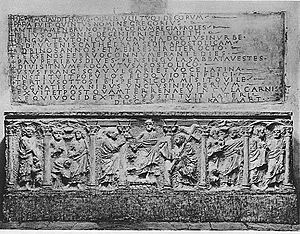Pope Gregory V facts for kids
Quick facts for kids Pope Gregory V |
|
|---|---|
| Bishop of Rome | |
| Church | Catholic Church |
| Papacy began | 3 May 996 |
| Papacy ended | 18 February 999 |
| Predecessor | John XV |
| Successor | Sylvester II |
| Personal details | |
| Birth name | Bruno of Carinthia |
| Born | c. 972 Stainach, Duchy of Carinthia, Holy Roman Empire |
| Died | 18 February 999 (aged c. 27) Rome, Papal States |
| Other Popes named Gregory | |
Pope Gregory V (born Bruno of Carinthia) was an important leader of the Catholic Church. He was the bishop of Rome and ruled the Papal States from May 3, 996, until he died on February 18, 999. He was born around 972. His cousin, Emperor Otto III, helped him become pope. Gregory V was part of the Salian dynasty, a powerful family at that time.
His Family Background
Bruno, who became Pope Gregory V, came from a very important family. His father was Otto I, Duke of Carinthia. His family, the Salian dynasty, was well-known and powerful. They were related to Holy Roman Emperor Otto I, a very famous ruler.
Becoming Pope
Before becoming pope, Bruno was a chaplain, which is like a priest, for his cousin, Emperor Otto III. The Emperor helped Bruno become the new pope. Bruno was chosen to take the place of John XV. When he became pope, he chose the name Gregory V.
Many people consider him the first German pope. Soon after he became pope, Emperor Otto III went back to Germany. While the Emperor was away, a group of Roman nobles chose someone else to be pope. This person was called antipope John XVI. An "antipope" is someone who claims to be the pope but is not officially recognized by the Church. Because of this, Gregory V had to leave Rome for a short time.
Important Decisions and Actions
Pope Gregory V worked closely with Emperor Otto III. He acted as the Emperor's representative in Rome. One of his first big actions was to crown Otto III as emperor on May 21, 996.
Together, they held a meeting called a synod. At this meeting, they decided that Arnulf, Archbishop of Reims, should get his position back. They also said that Gerbert of Aurillac was not allowed to be an archbishop.
Pope Gregory V also had a disagreement with King Robert II of France. The King wanted to choose bishops himself, but the Pope insisted that only the Church could do that. The Pope even used a strong punishment called excommunication on the kingdom. Excommunication meant that the King and his people were cut off from the Church. This made the King change his mind. He also had to separate from his wife, Bertha of Burgundy.
While Gregory V was pope, there was still trouble in Rome. John XVI, the antipope, and a powerful Roman noble named Crescentius II were in control of the city. Emperor Otto III returned to Rome with his army to stop this revolt. John XVI tried to run away, and Crescentius hid in a strong castle called the Castel Sant'Angelo.
The Emperor's soldiers caught the antipope John XVI. A respected holy man named St. Nilus of Rossano spoke out against the harsh way the Emperor and Pope treated John XVI. After this, John XVI was sent to a monastery in Germany. The Castel Sant'Angelo was attacked, and when it was captured, Crescentius was executed.
His Death
Pope Gregory V died suddenly on February 18, 999. Some people suspected that he might have been poisoned. He was buried in St. Peter's Basilica in Rome. His successor, the next pope, was Gerbert, who became Pope Sylvester II.
See also
 In Spanish: Gregorio V para niños
In Spanish: Gregorio V para niños


